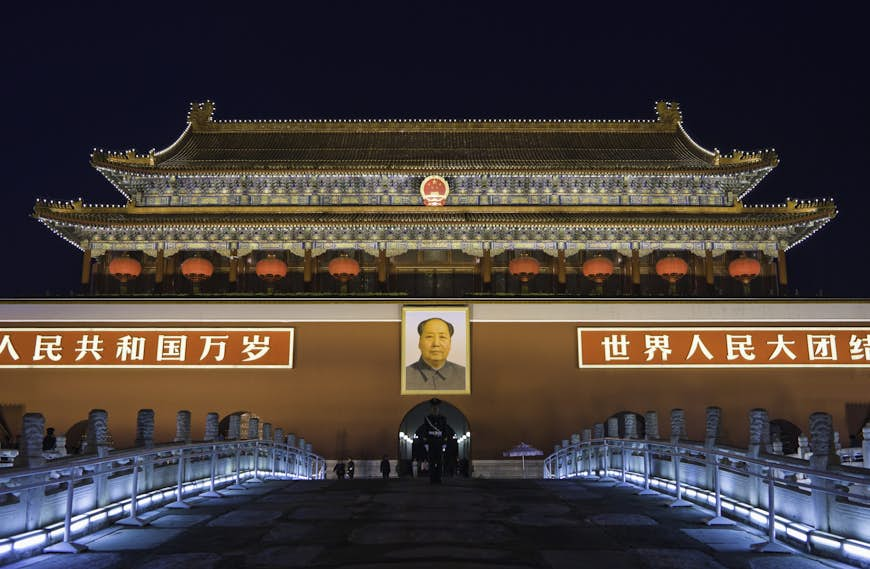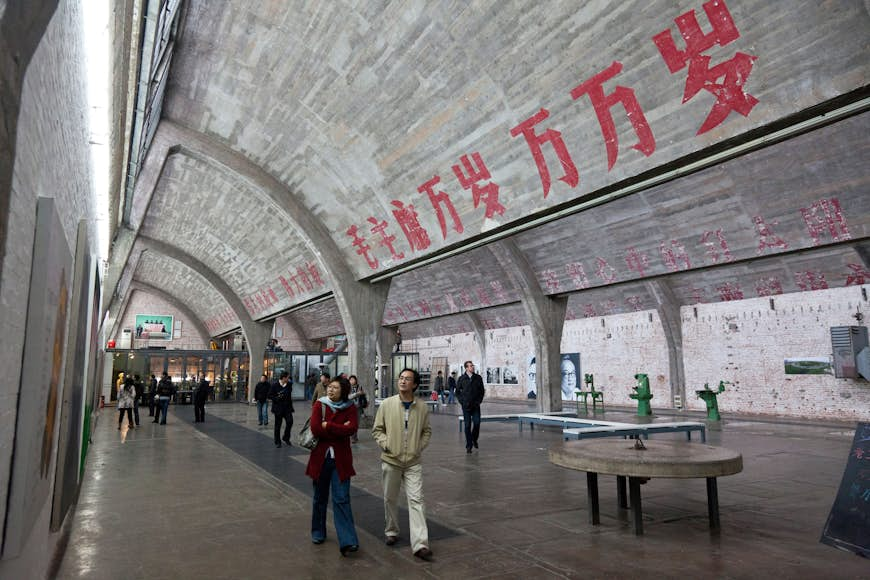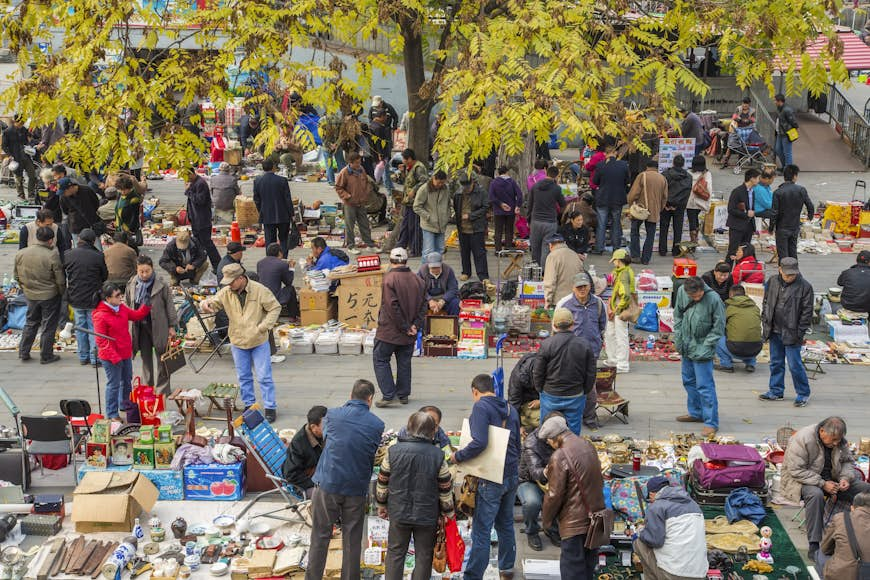
Compared to other big-name international cities, Beijing remains a very affordable destination for most tourists’ needs. Of course, that’s all relative to how much you want to splurge, but generally speaking, entrance fees are reasonably priced, public transport is inexpensive and eating out is mostly cheap and cheerful.
However, like anywhere in the world, things can add up fast once you factor in all the extras: hotels, speakeasy cocktail bars and pints of craft beer, tickets for gigs and cultural performances, not to mention taxis, airfares, travel insurance and visas.
But not to worry: you can counterbalance all that with all the free stuff to check out in Beijing. From contemporary Chinese culture to traditional arts and history, here’s our top 10 free things to do in Beijing.
Get the inside scoop on the latest cultural happenings all over the world delivered weekly to your inbox with our email newsletter.  Tian’anmen Square is both Beijing’s most iconic landmark and the national symbol of the People’s Republic of China © Danny Lehman / Getty Images
Tian’anmen Square is both Beijing’s most iconic landmark and the national symbol of the People’s Republic of China © Danny Lehman / Getty Images
Tian’anmen Square
Located in the heart of the city, Tian’anmen Square is both Beijing’s most iconic landmark and the national symbol of the People’s Republic of China. As the world’s largest public square, all military pomp and Soviet austerity, it’s a monumental sight with an atmosphere that’s as electrifying as it unnerving.
The square is flanked by socialist realism architecture of the National Museum of China and Great Hall of the People, while to the south are the impressive gates of Qiánmén and Zhengyang Gate Arrow Tower. To the north stands the Gate of Heavenly Peace, fronted by a giant portrait of Mao Zedong, who declared the founding of the People’s Republic of China right here on October 1, 1949.
The most popular time to visit is for the military flag-raising ceremony that takes place each day at sunrise and sunset. It gets busy then, however, so aim to come a bit earlier to ensure you get a good view.
Chairman Mao Memorial Hall
At the center of Tian’anmen Square lies one of Beijing’s most surreal sights: the mausoleum of China’s communist founder, Chairman Mao. Tourists flock here from across China’s far-flung provinces to pay their respects, joining a long, snaking queue for a fleeting glimpse of the Chairman himself. Despite Mao’s wishes to be cremated, his body was instead embalmed and displayed here, where it’s been on public view since 1977.
Wild Great Wall
Stretching magnificently across northern China on its 20,000-plus km (12,425-plus mile) journey, the Great Wall is without question one of the nation’s most enduring symbols. And Beijing is one of the best places to embark on trips to the wall, including several of the crumbling, untouched sections that aren’t ticketed.
While the areas with entrance fees won’t exactly break the bank, the free sections will give you a more peaceful experience, away from the jostling busloads of tourists, as befits a sight of such grandeur. Jiankou is one such section, and located around 100km (62 miles) from Beijing, it offers a more dilapidated, untouched feel, making it perfect for more intrepid hikers and travel photographers.
Ming City Wall Ruins Park
There’s more than one great wall to see in the Beijing area. Once spanning 24km (15 miles) around the city, the restored 15th-century Ming City Wall Ruins are the last remnants of the city’s 15m-high (49ft) inner walls. Today only 2km (1.2 miles) remain – the rest was torn down to accommodate Beijing’s ever-expanding roadways and subway system.
Set among peaceful parkland, the ruins make for a pleasant place to stroll and take in a slice of history as you contemplate what Beijing might look like in another 500 years time.
 The National Museum of China covers 5000 years of Chinese history through all the dynasties and ages © bushton3 / Getty Images
The National Museum of China covers 5000 years of Chinese history through all the dynasties and ages © bushton3 / Getty Images
National Museum of China
Beijing’s showpiece museum sits in a hulking 1950s Soviet-style building overlooking Tiananmen Square. It’s a vast space covering 5000 years of Chinese history through all the dynasties and ages, including Buddhist and Bronze art and sculptures. It’s free of charge, but as with other state museums, you’ll need to bring along your passport for entrance.
Other free museums worth a look include the Overseas Chinese History Museum for an interesting background on Chinese settlement abroad; Lu Xun Museum for a celebration of the father of modern Chinese literature; Capital Museum for some exquisite artifacts; and the Beijing Natural History Museum for dinosaur fossils (among many other species on display, including some questionable taxidermy).
National Art Museum
Another monumental Cultural Revolution–era building is this impressive art gallery showcasing works by Chinese and international artists. In addition to a permanent collection, it features ever-changing themed exhibitions on everything from ancient silk-scroll calligraphy to contemporary Chinese abstract painters. Don’t forget your passport for entry.
 Once a 1950s factory, the 798 arts precinct has faded cultural-revolution slogans still visible on the ceiling © Alamy Stock Photo
Once a 1950s factory, the 798 arts precinct has faded cultural-revolution slogans still visible on the ceiling © Alamy Stock Photo
798 Art Factory
One as much for art lovers as those into more offbeat attractions is this sprawling 798 arts precinct sprung from a 1950s factory – complete with faded cultural-revolution slogans still visible on the ceiling. Today it’s grown into a complex of galleries and public art installations showcasing the full gamut of emerging and established artists, as well as cafes, design shops, bars and live music venues. There’s a 798 app you can download to make getting around easier.
Hutongs
Unquestionably one of Beijing’s highlights are the traditional hutong residential areas. These distinctive neighborhoods comprise a maze of alleyways lined with courtyard houses, filled with the buzz of local gossip, playing kids and endless games of mah-jongg.
Unfortunately many of the hutongs have been bulldozed to make way for modern developments, but there are still areas you can wander, including around the Drum Tower, Lama Temple and the Xisi and Dashilar areas – the latter a former red-light district. Many of the houses have been converted into bars, guesthouses, galleries and cafes, but if you want to get the lowdown on their history, be sure to drop by Shijia Hutong Museum for some fascinating insights.
Modern architecture
While many come to Beijing to seek out old-world charms such as palaces, temples, gates, drum towers and pavilions, the city also has cutting-edge futuristic architecture on par with the world’s most modern metropolises. There’s no more iconic example than the National Stadium, affectionately known as the Bird’s Nest – the site of both the 2008 Beijing Olympics and 2022 Winter Olympics.
Designed in collaboration with dissident Chinese artist Ai Weiwei, the stadium’s circular shape was inspired by traditional ceramics, then wrapped in a latticework of twisted steel that glows spectacularly at night. It sits alongside the striking National Aquatics Centre; better known as the Water Cube, it was also used in the Olympics and has a bubbled exterior that’s likewise illuminated at night.
Other contemporary buildings are the silvery National Centre for the Performing Arts, which juts out from a body of water like a giant blob of mercury; the CCTV Headquarters – aka the Big Pants; and Beijing’s tallest building, the CITIC Tower, (better known as China Zun due to its resemblance to a zun, a traditional vase-like vessel). The late Zaha Hadid left her mark on town too, with the domed Galaxy Soho, the twisting Leeza Soho and the posthumously designed Beijing Daxing International Airport.
 Beijing’s Panjiayuan flea market doesn’t disappoint, with sprawling stalls of antiques and handicrafts © Peter Adams / Getty Images
Beijing’s Panjiayuan flea market doesn’t disappoint, with sprawling stalls of antiques and handicrafts © Peter Adams / Getty Images
Panjiayuan Market
Everyone loves a good flea market, and Beijing’s Panjiayuan doesn’t disappoint, with sprawling stalls of antiques and handicrafts. Browsing for unique keepsakes makes for an enjoyable hour or two; expect anything from calligraphy brushes to authentic Cultural Revolution propaganda and cigarette posters to Mao memorabilia and Buddhist artworks.



